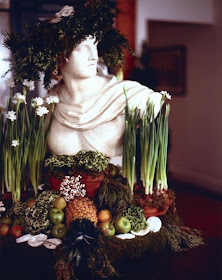
I know that envy is not in keeping with the holiday spirit, but I do envy those people who decorate their homes for the holidays in a most imaginative way. Take, for example, that homeowner who wrapped his home in thousands of blinking lights and created a light show set to the music of the Trans Siberian Orchestra. Admit it- you know exactly what I'm talking about. It's that video that made the YouTube and email rounds last year and if you see it one more time you're going to scream. Now, I don't want to decorate my home like that, but I've got to give that homeowner credit for his creativity.
Another way of decorating for Christmas is with a theme. Jonathan Preece of Bunny Williams Inc. does this but in a most unique way. (You might remember that I wrote about Jonathan's Thanksgiving table for a client.) For the holiday tableaux that he creates, Jonathan looks to Charles Dickens and Medieval England for inspiration. You won't find chasing lights in his decor either. He prefers using natural materials like evergreens, Juniper, Magnolia, and white flowers. And like all good designers, he is ever mindful of scale; you'll see that Jonathan usually incorporates one large objet within a mix of symmetrical and asymmetrical items in order to create balance.
Over the years, Jonathan has assembled some truly stunning vignettes in the Main Gallery at Bunny Williams Inc. After seeing these photos, I've decided that next year I'm going all-out in my own home. Just don't expect to hear the Trans Siberian Orchestra in the background.

For this tableau above and at top, the theme was Saturnalia, the ancient Roman celebration of the Winter Solstice. Jonathan used greenery, a traditional symbol of hope that Spring will soon be near. The assemblage was set in a circular fashion, another ancient symbol meaning eternity.
Jonathan chose 19th century stone garden finials as adornments on top of the painted, mirrored cabinets. The chandelier was a dilapidated, antique woven basket with defunct sockets which he transformed into taper candle holders. The life-sized 19th century plaster bust of Apollo took center stage in Jonathan's tableau. For many years, Apollo resided at John Rosselli's shop, but now he is ensconced in Jonathan's Tudor City apartment. (Jonathan says he's the best kind of roommate- looks pretty, doesn't talk back and never touches the drinks tray! I'd like one of those please.)
Surrounding Apollo were terracotta pots of narcissus, variegated mini Cedar plants, Granny Smith apples, bleached oyster shells, and cotton seeds. And of course, the single pineapple representing hospitality had a prominent role.


With another Christmas came a different scheme. This time Jonathan took his cue from two turtle doves. In the entryway to Bunny Williams Inc., two Regency Carrera marble busts on claret colored scagliola columns were crowned and mantled with cedar, spruce and juniper garlands.


The centerpiece here was the 19th c. zinc bird cage from Treillage. Yes, those were real doves inside, but don't fret. The birds took a Christmas vacation from All Tame Animals and were fed daily by one of the company's animal experts. Doves are a symbol of purity and life and were also chosen to commemorate a dear friend who had overcome cancer.
The table was covered in a late 18th c. silk gold on silver cloth in a fleur de lys pattern. Flowers and plants included potted Amaryllis, Hydrangea, succulents, and cedar branches. Seeded Eucalyptus was incorporated into the scheme because of its silvery tones which were in keeping with the blue tones of the painted cabinet, mercury glass, and antique zinc cage.


And finally, there was the Boars Head tableau. The Boars Head is an English tradition which dates back to the 16th c. and is still celebrated at Queens College, Oxford today. There was a celebrated carol, The Boars Head, which described the ancient custom of sacrificing a boar and presenting its head as part of a Yuletide feast. According to Jonathan, this bringing in of the boars head was later incorporated into the traditional Madrigal feast.
Now, regarding the boars head which was used for this particular tableau- I'm sure that some of you are angry at the use of taxidermy in design. I think it's important to note that this head was used for many years as a prop for an Iowa school's Madrigals. No boar was killed for this decoration.
An English Regency table was covered in an 18th c. Kilim rug. An early 19th c. sterling gallery tray was set with compotes filled with chestnuts and mini Bartlett pears. Garlands of Cedar and Magnolia were arranged with white grapes, bay leaves, rosemary sprigs, kumquats, plums, and cherries.
So, not only did we get a design lesson today, but a history one as well. I wonder what Jonathan will come up with next year?
(All images courtesy of Jonathan Preece)

















































